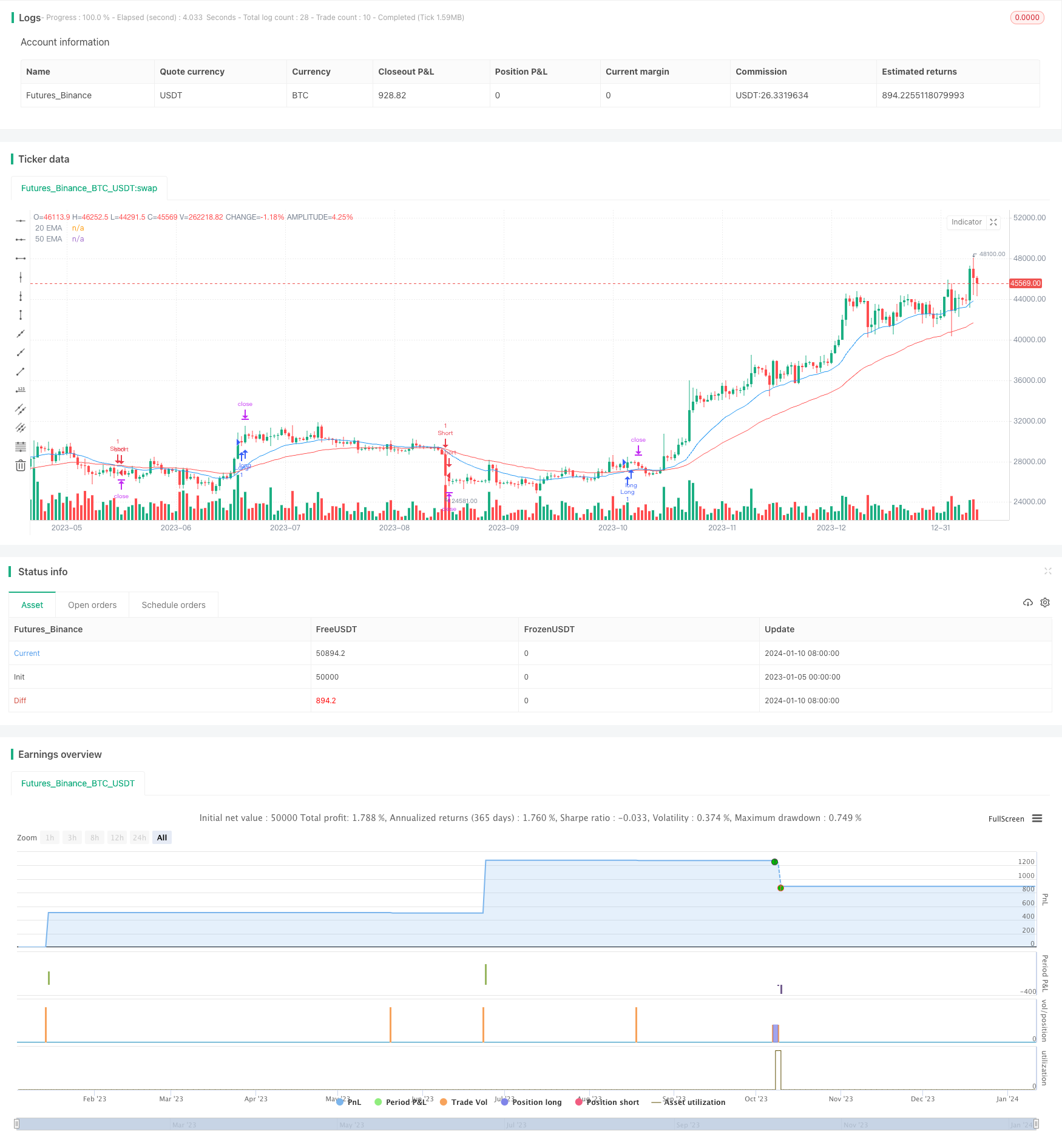
概述
该策略通过计算20日简单移动平均线(EMA20)和50日简单移动平均线(EMA50)的金叉和死叉来判断入场和出场时机。当EMA20上穿EMA50时,做多;当EMA20下穿EMA50时,做空。同时结合止损止盈机制来控制风险报酬。
策略原理
该策略的核心指标是20日EMA和50日EMA。EMA20代表短期趋势,EMA50代表中期趋势。当短期趋势上穿中期趋势时,表示行情由下跌转为上涨,做多能够获利;当短期趋势下穿中期趋势时,表示行情由上涨转为下跌,做空能够获利。因此,通过EMA20和EMA50的金叉死叉形态来判断入场和出场时机。
具体来说,首先计算20日EMA和50日EMA的值。然后在图表上画出EMA20和EMA50的线段。当发生EMA20上穿EMA50时,做多;当发生EMA20下穿EMA50时,做空。同时,输入止损比例和风险回报比来计算止损价位和止盈价位。如此可以有效控制单次交易的风险和回报。
优势分析
该策略具有以下优势:
- 使用EMA金叉死叉判断入场时机,可以有效捕捉趋势的转折点。
- 做多做空规则清晰简单,容易操作。
- 利用止损止盈来控制风险报酬比,有利于获取稳定收益。
- 资金使用效率高,无须长时间持仓。
风险分析
该策略也存在一些风险:
- EMA具有滞后性,可能错过价格反转的最佳时机。
- 止损点设置不当可能造成不必要的损失。
- 突发事件可能使EMA产生错误信号。
- 回测数据拟合风险。实盘效果可能与回测结果有差异。
优化方向
该策略可以从以下几个方面进行优化:
1.测试不同参数的EMA组合,寻找最佳参数。
2.结合其他指标进行信号过滤和验证。
3.动态调整止损止盈比例。不同行情下可以采用不同的止损止盈设置。
4.适当缩短持仓周期。降低受突发事件影响的概率。
总结
该EMA金叉死叉短线交易策略,通过简单的指标判定入场时机,利用止损止盈控制风险。易操作性强,适合短线活跃交易。但也存在一些问题,通过参数优化、信号过滤等手段可以进一步提高策略profit因子。
策略源码
/*backtest
start: 2023-01-05 00:00:00
end: 2024-01-11 00:00:00
period: 1d
basePeriod: 1h
exchanges: [{"eid":"Futures_Binance","currency":"BTC_USDT"}]
*/
//@version=5
strategy("Swing Trading with 20/50 EMA Cross", shorttitle = "EMA Cross", overlay = true)
// Define input for stop-loss and take-profit levels
var float stopLossPct = input.float(1, title = "Stop Loss (%)") / 100
var float rewardRiskRatio = input.float(2, title = "Risk-Reward Ratio")
takeProfitPct = stopLossPct * rewardRiskRatio
// Calculate EMA values
ema20 = ta.ema(close, 20)
ema50 = ta.ema(close, 50)
// Plot EMAs on the chart
plot(ema20, title = "20 EMA", color = color.blue)
plot(ema50, title = "50 EMA", color = color.red)
// Trading conditions
longCondition = ta.crossover(ema20, ema50)
shortCondition = ta.crossunder(ema20, ema50)
// Execute long and short trades
strategy.entry("Long", strategy.long, when = longCondition)
strategy.entry("Short", strategy.short, when = shortCondition)
// Calculate stop-loss and take-profit levels based on risk-reward ratio
stopLossPrice = close * (1 - stopLossPct)
takeProfitPrice = close * (1 + takeProfitPct)
strategy.exit("Take Profit/Stop Loss", stop = stopLossPrice, limit = takeProfitPrice)